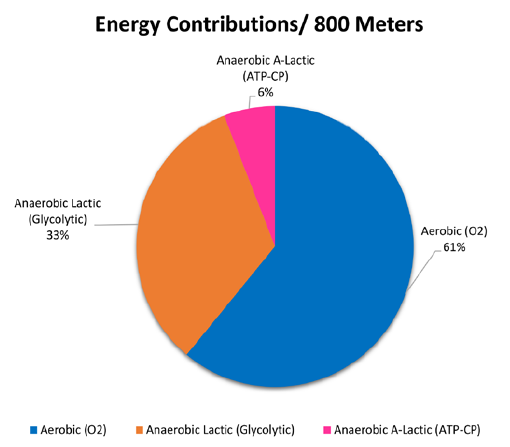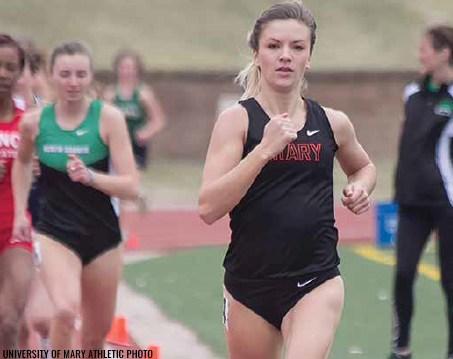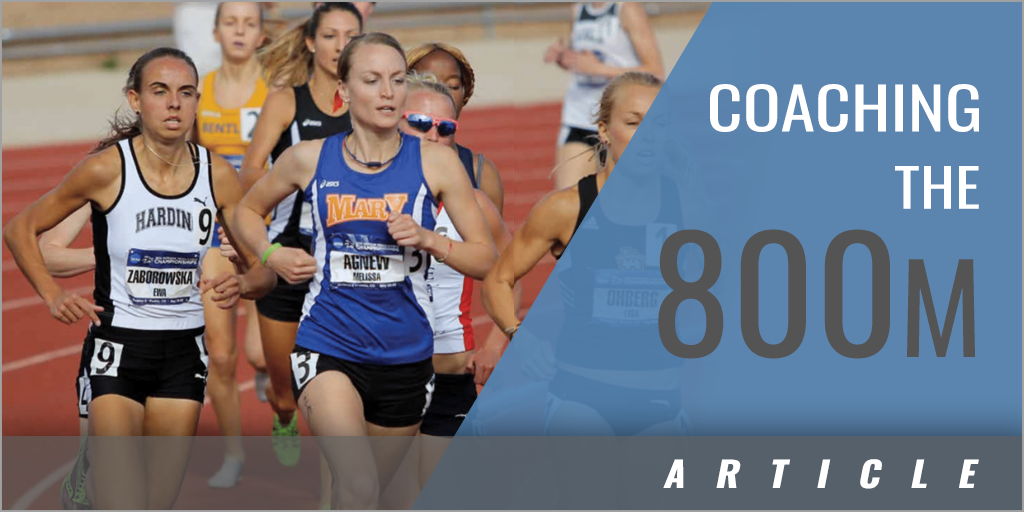By: Dennis Newell
Originally Published in: Techniques Magazine
Provided by: USTFCCCA
Two different student-athletes, two different personalities, two different training programs, one almost exact 800 meter result. This sentence is the reason I decided to look deeper into the 800-meter race and the training components that are necessary to achieve the desired results. Our program had two different student-athletes racing the 800 meters throughout the 2013 track seasons with relative success. Although these two women were talented and hard working alike, they were trained very differently to reach their athletic goals.

One student-athlete was coached with an emphasis on higher intensity and lower volume. This student-athlete was trained with the long
sprint group, and the emphasis was primarily Anaerobic Lactic (Glycolytic) and Anaerobic A-Lactic (ATP-CP). The other was coached with an emphasis on lower intensity and higher volume. This student-athlete trained with the distance group and ran cross-country successfully. Aerobic (O2) was the primary emphasis with Anaerobic Lactic (Glycolytic) being the secondary focus. Over many years, we have had student-athletes compete in the 400 meters, 400 meter hurdles, 600 meters, 800 meters, 1,000 meters, 1200 meter leg of a distance medley relay, 1500 meters, and mile that showed potential to run the 800 meter race successfully. With this being said, I decided to investigate what made both approaches successful in their own right, and how to adequately evaluate and coach individuals outside a ‘traditional' 800 meter race to find success in this event.
Some initial questions that were floating through my head were these:
- Is there a right and wrong way to train 800-meter student-athletes, and how is that determined?
- Is there one 800-meter training system that is perfect for everyone, based on the physiological science that makes up the 800 meter race?
- Do I train the event, or do I train the student-athlete as an individual?
I will start by saying I feel the middle distance events from 400-1500 meters (mile), are the most physiologically complex events to coach (the 800 meters possibly being the most complex). These events require the most diversity in training variables from speed, all the way to aerobic endurance and everything in between.
The 800-meters is a unique event. I look at a potential athlete's 400, 800 and 1500 meter marks to get a starting point of the athlete's ability in various events. I look at the physiological and biomechanical data, as well as the personality traits, of each potential student-athlete before determining if the 800 meters is the right training and competitive fit. You must be thorough in your evaluations in determining who is going to run the 800 meter race successfully.



THIS IS A PARALLEL COMPARISON OF TWO DIFFERENT METHODS OF TRAINING DIF-FERENT ATHLETES WITH DIFFERENT ATTRIBUTES AND MAKE-UP, BASED ON THEIR INDIVIDUAL STRENGTHS AND WEAKNESSES. BRIENNA IS CLEARLY TRAINING WITH MORE ANAEROBIC A-LACTIC (ATP-CP), AND LESS AEROBIC (02), THAN MELISSA. MELISSA IS TRAINING WITH MORE AEROBIC (02), AND LIMITED ANAEROBIC A-LACTIC (ATP-CP), WORK COMPARED TO BRIENNA. HOWEVER, THE KEY IS THAT THEY BOTH TRAINED RELATIVELY EQUAL IN THE ANAEROBIC LACTIC (GLYCOLYTIC) ENERGY SYSTEM BY THE END OF THEIR RACING SEASONS. THIS IS IMPORTANT BECAUSE THE ANAEROBIC LACTIC (GLYCOLYTIC) ENERGY SYSTEM ENCOMPASSES THE MOST SPECIFIC PACES TO THE 800-METER RACE. THEREFORE, ALTHOUGH BRIENNA AND MELISSA RELY ON DIFFERENT ENDS OF THE ENERGY SYSTEM SPECTRUM AS A MEANS TO THEIR END, THEY ALSO TRAIN VERY SIMILARLY IN REGARDS TO THE PERCENTAGE OF TRAINING THEY SPEND IN ARGUABLY THE MOST IMPORTANT ENERGY SYSTEM TO HAVING SUCCESS IN THE 800-METERS.

Going back to some of the original questions that were presented:
Is there a right and wrong way to train 800-meter student-athletes, and how is that determined?
The best way to coach the 800-meter student-athlete, and any student-athlete for that matter, is to communicate and develop a strong working relationship through accountability, commitment, discipline, hard work, ownership, passion and trust.
Is there one 800-meter training system that is perfect for everyone, based on the physiological science that makes up the 800 meter race?
No. There are too many variables that change the way each individual should be coached. Science and data are very important tools to use in developing training designs for any event, but common sense and understanding individual responses to stimuli are equally important.
Do I train the event, or do I train the student-athlete as an individual?
Both. Follow science when designing a training plan, and use history and experience to help guide that plan. However, use communication and adjust based on each individual's unique strengths and weaknesses to efficiently travel the route.
The training differences for Brienna and Melissa to compete in the same event are not so much a philosophy of two separate coaches' personal preferences on how to train the 800-meter race. However, the training differences for Brienna and Melissa to compete in the same event is based on two coaches collectively determining the best way
to get two individuals to a successful result in the same event. Going back to the original questions of why I wanted to investigate this event and subject: there is a right and wrong way to train the 800-meters, and there is no one way
to train this event. The physiological and biomechanical demands of the event, the psychological and emotional make-up
of each student-athlete, and the individual strengths and weaknesses of each student-athlete need to be considered collectively. Each variable needs to be fluid with the other to determine a productive relationship between all the variables collaborating towards a common goal. A good coach makes the system fit the athlete, not the other way around. There is no ‘one way' or ‘this worked for “enter awesome athlete's name here,”
so I know it works for anyone who puts in the work.' Individuals need individual coaching based on many different variables. The more time we can put into understanding each individual's needs and responses, the greater the chance for that individual to reach their potential.
There needs to be an open line of communication, honest feedback on both sides, and respect for each other, for a great working relationship to be present. Communication between the student-athlete and the coach is of vital importance to develop each athlete to their potential.
Knowledge + Application = Results
Results + Adjustments = Progress Repeat
RESOURCES
Abbot, Scott. Coaching the 800
Meters. USTFCCCA Coaches Convention Symposium. San Antonio, TX. 2011.
Bompa, Tudor. Periodization Training for Sports. 3rd ed. Human Kinetics Publishers: 2015.
Christensen, Scott. The Lactate Dilemma in Middle Distance Training. USTFCCCA Coaches Convention Symposium. Phoenix, AZ. 2014.
Daniels, J. Daniel's Running Formula. 1st Ed. Human Kinetics Publishers: 1998.
Hart, Clyde. 400 Training Baylor Style. USTFCCCA Coaches Convention Symposium. Orlando, FL. 2013.
Heines, Eric. Balancing Speed Development with Aerobic Training. USTFCCCA Coaches Convention Symposium. Orlando, FL. 2013.
Schexnayder, Boo. Boo Schexnayder's Complete Training Inventory. SAC Speed. http://www.sacspeed.com/wp/
Schexnayder, Boo. Speed and Ancillary Training in the Distance Events. SAC Speed. http://www.sacspeed.com/wp/
Conversations with Scott Christensen, Ryun Godfrey, Mike Thorson, and Gary Wilson.
BIO: DENNIS NEWELL IS THE HEAD TRACK & FIELD AND CROSS COUNTRY COACH AT THE UNIVERSITY OF MARY IN BISMARCK, ND. NEWELL HAS PREVIOUSLY BEEN NAMED AS DIVISION II NATIONAL COACH OF THE YEAR BY THE USTFCCCA.






